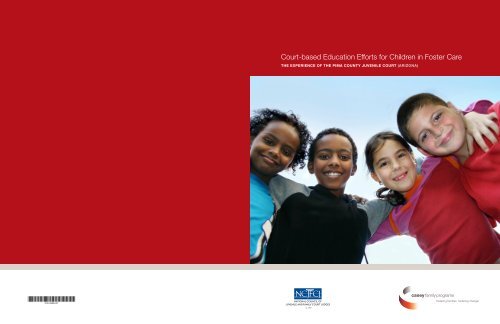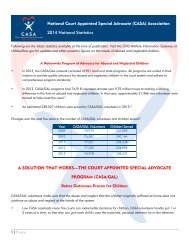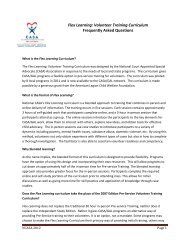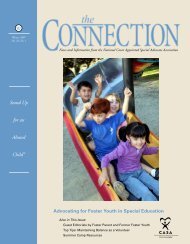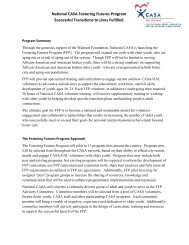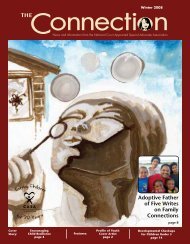Court-based Education Efforts for Children in ... - National CASA
Court-based Education Efforts for Children in ... - National CASA
Court-based Education Efforts for Children in ... - National CASA
You also want an ePaper? Increase the reach of your titles
YUMPU automatically turns print PDFs into web optimized ePapers that Google loves.
Pima County Juvenile<strong>Court</strong>—At a GlancePima County is the second mostpopulous county <strong>in</strong> Arizonaand <strong>in</strong>cludes the city of Tucson,where the Pima County Juvenile<strong>Court</strong> is <strong>based</strong>.Judges and Other Key Stakeholders Agree That <strong>Education</strong> is an Important andChalleng<strong>in</strong>g Issue to AddressDur<strong>in</strong>g July 2006, Casey Family Programs partnered with the <strong>National</strong> Council of Juvenileand Family <strong>Court</strong> Judges (NCJFCJ) to conduct a national survey of dependency courtjudges, key stakeholders <strong>in</strong>volved <strong>in</strong> dependency cases, and <strong>Court</strong> Appo<strong>in</strong>ted Special Advocates(<strong>CASA</strong>s). The <strong>in</strong>tent of the survey was to identify current barriers or challengesto meet<strong>in</strong>g the educational needs of children and youth <strong>in</strong> foster care and—ultimately—to<strong>in</strong><strong>for</strong>m improvements <strong>in</strong> practice, policy, and/or procedure. A total of 169 judges, 65 keystakeholders, and 1,117 <strong>CASA</strong>s completed the survey. There was widespread agreement byall respondents that judges have a role <strong>in</strong> ensur<strong>in</strong>g that the educational needs of youth <strong>in</strong>care are met.In particular, the follow<strong>in</strong>g issues were noted:• School placement stability is a significant concern. Over half of the survey respondentsreported that movement of a child from one foster home/placement to another results <strong>in</strong> aschool change at least 40% of the time. The transfer of records and paperwork was cited asthe number one barrier to timely school enrollment.• Special education services are often lack<strong>in</strong>g. The court does not always address issues ofspecial education on a regular basis. Discussion around the development and adherence toan Individualized <strong>Education</strong> Plan (IEP) occurred less than 40% of the time <strong>in</strong> cases whereit was necessary, accord<strong>in</strong>g to key stakeholders and <strong>CASA</strong>s.• <strong>Children</strong> do not always have educational advocates <strong>in</strong> court. Less than half of the respondentsreported that children always have an educational advocate <strong>in</strong> the courtroom whenthey need one.Despite the importance placed on education, however, limited resources and compet<strong>in</strong>gchallenges often make it difficult to thoroughly address this issue <strong>in</strong> the courtroom. The majorityof respondents cited time constra<strong>in</strong>ts and high caseloads as the dom<strong>in</strong>ant barriers toaddress<strong>in</strong>g issues of education <strong>in</strong> the courtroom. Other barriers identified by judges <strong>in</strong>cludedcaseworkers who are unprepared or not knowledgeable about educational issues, a lack of<strong>in</strong><strong>for</strong>mation from or <strong>in</strong>volvement of the school, and <strong>in</strong>frequency of court hear<strong>in</strong>gs.Judicial Officers• The Presid<strong>in</strong>g Judge ma<strong>in</strong>ta<strong>in</strong>sa caseload and manages theJuvenile <strong>Court</strong> with the assistanceof the <strong>Court</strong> Adm<strong>in</strong>istrator.• Five judges and six judges protempore/commissioners rotatethrough the Juvenile <strong>Court</strong>with a three-year m<strong>in</strong>imumcommitment.Jurisdiction• The <strong>Court</strong> has exclusive jurisdictionover all dependencymatters, severances, and adoptions,as well as all childrenunder the age of 18 who arereferred to the court due tomental health issues, <strong>in</strong>corrigibility,or del<strong>in</strong>quency.• On December 31, 2005,there were 3,068 abused andneglected children under thejurisdiction of the court (a7.6% <strong>in</strong>crease from 2004).In 2005, a total of 985 newabuse and neglect petitionswere filed, with the averagedependency caseload <strong>for</strong> theyear at 143 cases.• In 2005, permanency wasachieved <strong>for</strong> 38.5% of childrenunder the court’s jurisdictionby reunification(19.1%), adoption (11.5%),relative placement (2.5%),legal guardian placement(4.8%), and other plannedpermanent liv<strong>in</strong>g arrangement(0.7%).Pima County’s RoadMap to <strong>Education</strong> Re<strong>for</strong>mThe Committee to Improve <strong>Education</strong>al Outcomes<strong>for</strong> <strong>Court</strong>-Involved YouthPima County’s road map to education re<strong>for</strong>m began <strong>in</strong> January2003 when the Juvenile <strong>Court</strong> established the Committee toImprove <strong>Education</strong>al Outcomes <strong>for</strong> <strong>Court</strong>-Involved Youth asa subcommittee of the Dependency Model <strong>Court</strong>. The goal ofthis committee was to explore ways <strong>in</strong> which educational outcomes<strong>for</strong> youth <strong>in</strong> foster care could be improved. Its <strong>in</strong>ceptionwas the result of the vision of Cathleen Fitzgerald, <strong>CASA</strong>Coord<strong>in</strong>ator and Community Volunteer, and Sharon Dobb<strong>in</strong>,<strong>Education</strong> Specialist at Casey Family Programs. The 12 orig<strong>in</strong>almembers of the committee <strong>in</strong>cluded representatives from childprotective services (CPS), Casey Family Programs, the Juvenile<strong>Court</strong> Dependency Unit, <strong>CASA</strong>, several school districts, the AttorneyGeneral’s office, and Judge Suzanna Cuneo.At the onset, the committee focused on access<strong>in</strong>g exist<strong>in</strong>g resourcesthrough Casey Family Programs and TeamChild <strong>in</strong>Wash<strong>in</strong>gton State to both field test a new Judicial <strong>Education</strong>Checklist 11 and to organize a juvenile court-<strong>based</strong> tra<strong>in</strong><strong>in</strong>gaimed at <strong>in</strong>creas<strong>in</strong>g the awareness of educational issues facedby children <strong>in</strong> foster care. Table 1 describes the projects thatwere identified at this tra<strong>in</strong><strong>in</strong>g that became the focus <strong>for</strong> thecommittee’s work <strong>in</strong> 2003–2005. | <strong>Court</strong>-<strong>based</strong> education ef<strong>for</strong>ts <strong>for</strong> children <strong>in</strong> foster carethe experience of the pima county juvenile court |
Table 1. Lay<strong>in</strong>g the Foundation <strong>for</strong> Re<strong>for</strong>m: Initial Projects (2003–2005)Project Problem SolutionTable 2. Mov<strong>in</strong>g Implementation Forward: <strong>Court</strong>-wide Projects (2005-2006)Project Problem SolutionM<strong>in</strong>ute EntryOrderJudicial<strong>Education</strong>ChecklistReluctance of schools to shareeducational records with CPS casemanagers due to confidentialitylaws.<strong>Education</strong> was not be<strong>in</strong>g addressed<strong>in</strong> court or <strong>in</strong> other areas of fosteryouths’ lives (e.g., case managerreports).Pima County resolved the issue and the delay <strong>in</strong> enroll<strong>in</strong>gchildren <strong>in</strong> school, by creat<strong>in</strong>g a separate M<strong>in</strong>uteEntry Form that is signed by the judge at the time of theprelim<strong>in</strong>ary protective hear<strong>in</strong>g (PPH), allow<strong>in</strong>g CPS toaccess school records without prior consent of a parentor guardian or the <strong>in</strong>volvement of a surrogate parent.Achieved <strong>in</strong> 2005 and implemented statewide. 12Identified and <strong>in</strong>corporated education-specific questionsfrom Ask<strong>in</strong>g the Right Questions: A Judicial Checklist toEnsure that the <strong>Education</strong>al Needs of <strong>Children</strong> and Youth<strong>in</strong> Foster Care Are Be<strong>in</strong>g Addressed <strong>in</strong>to the PPH process.13 Achieved <strong>in</strong> 2004.<strong>Education</strong>AdvocacyManualCollaborativeTra<strong>in</strong><strong>in</strong>gsCareer DayLack of education advocates <strong>for</strong> children andyouth <strong>in</strong> foster care.Those <strong>in</strong>volved <strong>in</strong> the lives of foster youthnot tra<strong>in</strong>ed <strong>in</strong> education issues and have fewresources.Lack of knowledge of education issues andoutcomes <strong>for</strong> youth <strong>in</strong> out-of-home care.Very few youth leav<strong>in</strong>g high school and go<strong>in</strong>gon to postsecondary education. Lack ofexposure to and knowledge of postsecondaryeducation.F<strong>in</strong>alized <strong>in</strong> 2005. Tra<strong>in</strong><strong>in</strong>gs on the manual are be<strong>in</strong>gscheduled <strong>for</strong> CPS, probation, attorneys, and courtstaff (<strong>in</strong> early 2006).Implemented collaborative tra<strong>in</strong><strong>in</strong>gs such as homelessassistance, surrogate parent, special education advocacy,and the McK<strong>in</strong>ney-Vento Act. 14Organized and held a Career Day <strong>in</strong> Spr<strong>in</strong>g 2006 15 <strong>for</strong>court-<strong>in</strong>volved youth <strong>in</strong> conjunction with Pima CommunityCollege.Tutor List<strong>Children</strong> and youth <strong>in</strong> foster careare beh<strong>in</strong>d academically and arenot gett<strong>in</strong>g enrichment at school.Money is available <strong>for</strong> tutor<strong>in</strong>g butf<strong>in</strong>d<strong>in</strong>g a tutor is extremely difficult.Developed a tutor list. This is currently be<strong>in</strong>g <strong>in</strong>corporated<strong>in</strong>to a Pima County <strong>Education</strong> Resource Guide(developed <strong>in</strong> 2005).<strong>Court</strong>ManagementPresentationAll systems work<strong>in</strong>g with court-<strong>in</strong>volved youthhave a need <strong>for</strong> educational advocacy assistance.Made a presentation to the Presid<strong>in</strong>g Judge and courtmanagement by <strong>CASA</strong> to offer educational advocacyassistance to CPS workers and probation officers ondifficult cases.AddressSurrogateParent Issues<strong>Children</strong> and youth <strong>in</strong> foster carewere not gett<strong>in</strong>g special educationservices due to <strong>in</strong>sufficient numbersof surrogates and confusionregard<strong>in</strong>g surrogate law.Formed a subcommittee <strong>in</strong> early 2004 to work on issuessuch as expand<strong>in</strong>g the distribution list <strong>for</strong> surrogate parentorders to <strong>in</strong>clude the surrogate, identify<strong>in</strong>g and creat<strong>in</strong>ga list of available and tra<strong>in</strong>ed surrogate parents, andorganiz<strong>in</strong>g and implement<strong>in</strong>g a tra<strong>in</strong><strong>in</strong>g <strong>for</strong> court staff.Achieved. The tra<strong>in</strong><strong>in</strong>g <strong>for</strong> court staff was held <strong>in</strong> 2005.<strong>Education</strong>alAdvocacyServices <strong>for</strong> All<strong>Court</strong>-<strong>in</strong>volvedYouthLack of education advocates <strong>for</strong> court-<strong>in</strong>volvedyouth. Lack of parental <strong>in</strong>volvement and knowledgeregard<strong>in</strong>g education issues. Youth notmeet<strong>in</strong>g the conditions of probation—attend<strong>in</strong>gschool. Probation officers and case managerslack the time and resources needed to do<strong>in</strong>tensive education work.A group of <strong>CASA</strong> volunteers created a proposal to<strong>in</strong>corporate educational advocacy services <strong>for</strong> allcourt-<strong>in</strong>volved youth <strong>in</strong>to the <strong>for</strong>mal court process.(Began <strong>in</strong> 2003.) Through a collaborative ef<strong>for</strong>t with keystakeholders, space was made available <strong>in</strong> the courthousealong with access to computers and phones <strong>for</strong>educational consultants <strong>in</strong>creas<strong>in</strong>g their visibility andaccessibility. (January 2006). In the first six months,education consultants responded to 52 requests cover<strong>in</strong>gtopics such as the McK<strong>in</strong>ney-Vento Act, tutor<strong>in</strong>g,special education, enrollment, expulsion, and GED.Expand<strong>in</strong>g the <strong>Education</strong> CommitteeIn February 2005, the <strong>Education</strong> Committee expanded <strong>in</strong>to a court-wide committee to be <strong>in</strong>clusive ofall court-<strong>in</strong>volved m<strong>in</strong>ors. The committee’s membership grew to 37 and <strong>in</strong>cluded representatives from 6school districts <strong>in</strong> Pima County, Pima Community College, Pima County Super<strong>in</strong>tendents Office, CPS,<strong>CASA</strong>, juvenile probation, juvenile detention, group care facilities, the public defender, contract attorneys,the county attorney, the Attorney General’s office, and all areas of juvenile court. The committee’soverall goal became to reach a time when every court-<strong>in</strong>volved m<strong>in</strong>or would be assured of the developmentand implementation of a specific educational plan designed <strong>for</strong> the needs of that particular m<strong>in</strong>or. The committeeidentified the follow<strong>in</strong>g issues as key components to address <strong>in</strong> 2005:• Provid<strong>in</strong>g court-wide tra<strong>in</strong><strong>in</strong>g on educational advocacy, special education issues, and the Judicial <strong>Education</strong>Checklist• Increas<strong>in</strong>g collaborative ef<strong>for</strong>ts between CPS, probation, and the schools, <strong>in</strong>clud<strong>in</strong>g alternative schools,Pima Community College, and trade schoolsPilot Projectwith DetentionSurrogateParentsExpansionReportRe<strong>for</strong>matt<strong>in</strong>gPart of the need <strong>for</strong> educational advocacyservices stated above.Cont<strong>in</strong>ued shortage of surrogate parents.<strong>Education</strong> addressed only briefly (if at all) <strong>in</strong> thesection titled “<strong>Children</strong>’s Placement.” Unableto identify school moves that have occurred <strong>for</strong><strong>in</strong>dividuals.Began implementation of a pilot project with Detentionand an identified group home <strong>in</strong> order to collaborate<strong>in</strong> develop<strong>in</strong>g behavioral plans <strong>for</strong> youth <strong>in</strong> detentionaimed at reduc<strong>in</strong>g the “revolv<strong>in</strong>g door.”Through a collaborative ef<strong>for</strong>t with Tucson UnifiedSchool District, the Surrogate Parent Tra<strong>in</strong>er, local<strong>CASA</strong> program, and local service providers, the list ofavailable surrogate parents expanded from 60 to 120volunteers. In addition, the subcommittee (describedabove) created a protocol <strong>for</strong> surrogate parent procedures.Re<strong>for</strong>matted the child welfare agency reports to thecourt to <strong>in</strong>clude specific sections on the educationalexperience of youth.Table 2 <strong>in</strong>cludes the specific projects undertaken by the court-wide committee <strong>in</strong> 2005–2006.Tip SheetComplicated education laws.Lack of ongo<strong>in</strong>g tra<strong>in</strong><strong>in</strong>g <strong>in</strong> education <strong>for</strong> newcase managers.Created an education case plan and “education plann<strong>in</strong>g<strong>for</strong> children <strong>in</strong> CPS Care” tip sheet. | <strong>Court</strong>-<strong>based</strong> education ef<strong>for</strong>ts <strong>for</strong> children <strong>in</strong> foster carethe experience of the pima county juvenile court |
The Impact of Pima County’s <strong>Ef<strong>for</strong>ts</strong> on <strong>Court</strong> PracticeThe impact of Pima County’s educational re<strong>for</strong>m <strong>in</strong>itiatives has not yet been fully and comprehensivelyevaluated, and currently there is no data track<strong>in</strong>g system <strong>in</strong> place. However, a prelim<strong>in</strong>ary review of Juvenile<strong>Court</strong> records was undertaken by NCJFCJ as part of this chronicl<strong>in</strong>g ef<strong>for</strong>t and to provide a measureof the degree to which court practice is focused on educational needs and outcomes (e.g., throughjudicial orders, reports to the court, motions, etc.). In addition, Casey Family Programs conducted focusgroups with Pima County youth <strong>in</strong> foster care, foster parents, and case managers to solicit <strong>in</strong>put on theirexperiences of how the educational needs of children and youth <strong>in</strong> foster care are be<strong>in</strong>g addressed <strong>in</strong> PimaCounty.Case Record ReviewsA review of 30 randomly selected court files and accompany<strong>in</strong>g social service agency exhibits determ<strong>in</strong>edthat:• <strong>Education</strong> issues are addressed as part of rout<strong>in</strong>e court practice <strong>in</strong> Pima County, regardless of whetherthere is an identified educational issue <strong>in</strong> the case. This occurs as early as the first hear<strong>in</strong>g after removaland petition fil<strong>in</strong>g. The judge specifically addressed the educational needs of the child at the PPH <strong>in</strong>the majority of cases reviewed (92%; n=28).• At the PPH, judges were directly <strong>in</strong>quir<strong>in</strong>g about provision of school supplies, change <strong>in</strong> placementand change <strong>in</strong> school, the mental health needs of the children and how these might affect school progressand achievement, and concerns about the division of educational responsibilities.• Judicial m<strong>in</strong>ute orders, caseworker reports, and <strong>CASA</strong> and Foster Care Review reports typically addressedthe categories of <strong>in</strong><strong>for</strong>mation suggested <strong>in</strong> the Judicial <strong>Education</strong> Checklist (e.g., enrollment,attendance, transportation, supplies, per<strong>for</strong>mance, change <strong>in</strong> placement/change <strong>in</strong> school, health factorsimpact<strong>in</strong>g education, extracurricular activities, and talents).• By the adjudication stage of proceed<strong>in</strong>gs, education issues were be<strong>in</strong>g resolved. School records wereobta<strong>in</strong>ed <strong>in</strong> 35% of the cases <strong>for</strong> which they were previously unavailable (n=11), children were enrolled<strong>in</strong> school <strong>in</strong> 35% of the cases where they had previously not been enrolled (n=11), and educational assessmentsor evaluations were obta<strong>in</strong>ed <strong>in</strong> 23% of the cases (n=7).• Overall, by the permanency hear<strong>in</strong>g stage, 82% of the cases coded (n=25) had seen progress or resolutionon educational issues identified at earlier stages of the proceed<strong>in</strong>gs.For more detailed <strong>in</strong><strong>for</strong>mation about this study of Pima County’s educational re<strong>for</strong>m ef<strong>for</strong>ts,<strong>in</strong>clud<strong>in</strong>g method used, please see the report available onl<strong>in</strong>e at www.ncjfcj.org.Focus GroupsFocus groups were conducted with 7 Pima County youth <strong>in</strong> foster care and 1 alumnus, 7 foster parents,and 13 case managers. The results of the focus groups <strong>in</strong>dicate both that improvements have been madeand that there is still work to be done.Steps towards improvements <strong>in</strong>clude more education tra<strong>in</strong><strong>in</strong>gs be<strong>in</strong>g available <strong>for</strong> foster parents and casemanagers, several youth and some parents be<strong>in</strong>g asked consistently about education issues by judges,some case managers recogniz<strong>in</strong>g the Judicial <strong>Education</strong> Checklist as be<strong>in</strong>g used <strong>in</strong> court, and the availabilityof education consultants to help case managers.Recommendations <strong>for</strong> improvements by youth <strong>in</strong>cluded more tutor<strong>in</strong>g help, support <strong>in</strong> gett<strong>in</strong>g appropriateclasses, opportunities to learn study skills, transportation, and the ability to participate <strong>in</strong> extracurricularactivities. Other potential re<strong>for</strong>m ef<strong>for</strong>ts <strong>based</strong> on focus group comments might <strong>in</strong>clude more youthand parents attend<strong>in</strong>g and participat<strong>in</strong>g <strong>in</strong> hear<strong>in</strong>gs and Foster Care Review Board reviews and view<strong>in</strong>gcourt reports, required education tra<strong>in</strong><strong>in</strong>g <strong>for</strong> foster parents and case managers, and a more evident useof the Judicial <strong>Education</strong> Checklist, <strong>in</strong>clud<strong>in</strong>g hav<strong>in</strong>g case managers use it to write the education area ofcourt reports. | <strong>Court</strong>-<strong>based</strong> education ef<strong>for</strong>ts <strong>for</strong> children <strong>in</strong> foster carethe experience of the pima county juvenile court |
Lessons Learned:Implementation Elements and Strategies to SuccessPima County stakeholders found the follow<strong>in</strong>g issues critical to consider when implement<strong>in</strong>g <strong>in</strong>itiativesto ensure that youth <strong>in</strong> foster care experience successful educational outcomes:• School placement stability. Allow children to rema<strong>in</strong> <strong>in</strong> their home schools after a risk assessment determ<strong>in</strong>esthat it is safe to do so and <strong>in</strong> the student’s best <strong>in</strong>terest.• Portable records <strong>for</strong> prompt enrollment. Students should not be denied enrollment due to a delay <strong>in</strong>records be<strong>in</strong>g transferred to their new school (e.g., immunization records, birth certificate).• Confidentiality and collaboration. Agencies will need to collaborate to ensure that appropriate <strong>in</strong><strong>for</strong>mationis shared and agreements are developed that meet federal and state standards.Road map <strong>for</strong> <strong>Education</strong> Re<strong>for</strong>m: Elements and StrategiesNecessary ElementsF<strong>in</strong>d judicialleadershipIdentify and <strong>in</strong>volve all keystakeholdersStrategies• Identify a champion• Identify both natural allies and those not supportive• Ensure membership is <strong>in</strong>clusive; ask, “Who is miss<strong>in</strong>g?”• Involve multiple alumniIn addition, Pima County stakeholders identified the elements and accompany<strong>in</strong>g strategies thathave been necessary to effectively plan and implement their educational re<strong>for</strong>m ef<strong>for</strong>ts. Theseare summarized on the next page <strong>in</strong> the “Road Map <strong>for</strong> <strong>Education</strong> Re<strong>for</strong>m” and detailed morethoroughly below.F<strong>in</strong>d judicial leadershipPima County stakeholders believed it imperative that ef<strong>for</strong>ts be spearheaded by a judge who is <strong>in</strong>terested<strong>in</strong> the issue and will<strong>in</strong>g to delve <strong>in</strong>to the details. Judicial leadership and buy-<strong>in</strong> provide the credibility andfocus on the issue needed to open doors that other stakeholders may not be able to. If the judge believesimproved educational outcomes <strong>for</strong> children <strong>in</strong> foster care are important, and educational questions areasked from the bench, then everyone else responds.Hav<strong>in</strong>g a champion who will move the issues <strong>for</strong>ward is another critical component. If a champion doesnot step <strong>for</strong>ward, it is vital <strong>for</strong> the courts to identify an effective person <strong>for</strong> this role, not only to add value<strong>in</strong>side the court but also to garner and wield community <strong>in</strong>fluence.Active and consistent <strong>in</strong>volvementof committee membersCollaboration of similar issuecommitteesSchool district <strong>in</strong>volvementand buy-<strong>in</strong>Tools and resources• Develop annual goals with concrete timel<strong>in</strong>es and responsible parties• Share chair responsibilities• Identify issues and barriers• Establish smaller work groups• Review and highlight accomplishments• Identify one “umbrella” committee to oversee and coord<strong>in</strong>ate ongo<strong>in</strong>g ef<strong>for</strong>ts• Educate districts about needs of children <strong>in</strong> foster care• Make connection between behavior of children <strong>in</strong> foster care and environment theywere removed from• Create tools and resources tailored to the jurisdiction/court’s need, <strong>in</strong>clud<strong>in</strong>g tra<strong>in</strong><strong>in</strong>gcurriculum and materialsIdentify and <strong>in</strong>volve all key stakeholdersIt is important to identify key stakeholders, both those who are natural allies and supporters and thosewho do not support the cause. It is also important to develop a strategy to engage all stakeholders, especiallythose who are not supportive, without plac<strong>in</strong>g blame on any particular organization or agency. Andit is critical to ensure that all levels of stakeholders are <strong>in</strong>volved, both direct service workers and policy ordecision-makers.Data collection and projectevaluation• Conduct an <strong>in</strong><strong>for</strong>mal survey to determ<strong>in</strong>e amount of time dedicated to address<strong>in</strong>geducational issues• Gather data on Judicial <strong>Education</strong> Checklist questions asked at the PPH• Modify exist<strong>in</strong>g data system to collect data relevant to educational outcomes• Periodically solicit feedback from key players• Follow youth who attend Career Day, or other relevant events, to determ<strong>in</strong>eeducational outcomesAn effective strategy employed by the Pima County Committee has been to ensure that membership is<strong>in</strong>clusive. Members would consistently ask themselves who was miss<strong>in</strong>g and then develop a recruitmentplan to <strong>in</strong>crease <strong>in</strong>volvement and the success of buy-<strong>in</strong>. They also learned to <strong>in</strong>volve numerous alumni offoster care so that <strong>in</strong>dividuals did not feel asked to speak <strong>for</strong> all youth.Youth’s voice heard <strong>in</strong> court • Have committee exam<strong>in</strong>e the benefits of youth attend<strong>in</strong>g court hear<strong>in</strong>gsAddress student suspensionand expulsion• Form a committee to spearhead issue• Have committee <strong>in</strong>vestigate alternatives to ensure educational cont<strong>in</strong>uity10 | <strong>Court</strong>-<strong>based</strong> education ef<strong>for</strong>ts <strong>for</strong> children <strong>in</strong> foster care the experience of the pima county juvenile court | 11
Active and consistent <strong>in</strong>volvement of committee membersOne of the most difficult aspects of collaboration is ensur<strong>in</strong>g active and consistent <strong>in</strong>volvement by allkey stakeholders. Often, key players are well-mean<strong>in</strong>g and supportive of address<strong>in</strong>g the issues <strong>in</strong> a collaborativeand <strong>in</strong>novative way, but they may be unable to consistently participate <strong>in</strong> all meet<strong>in</strong>gs due totheir everyday work and caseload demands. Another struggle is the management of a large committeegiven the ebb and flow of members. The Pima County committee has experienced the departure of somemembers because these members perceived that their immediate needs were not be<strong>in</strong>g met by the work ofthe committee.Strategies used by Pima County to keep committee members <strong>in</strong>volved <strong>in</strong>cluded:• Shar<strong>in</strong>g chair responsibilities. Pima County shared this responsibility between three core members,which allowed movement <strong>in</strong> and out of the role as chair (br<strong>in</strong>g<strong>in</strong>g a fresh perspective and focus) whileensur<strong>in</strong>g that the long-range goals and vision cont<strong>in</strong>ue to move <strong>for</strong>ward. 16• Identify<strong>in</strong>g issues and barriers. It is imperative to the life of a committee that all potential (real orperceived) barriers to resolv<strong>in</strong>g the issues are identified at the outset. Pima County found that the lackof awareness of the issue was a major barrier to accomplish<strong>in</strong>g their goals. Consequently, it developeda strategy to <strong>in</strong>crease awareness, <strong>in</strong>clud<strong>in</strong>g but not limited to cross-tra<strong>in</strong><strong>in</strong>g <strong>in</strong> discipl<strong>in</strong>es work<strong>in</strong>g withchildren and families on educational needs.• Develop<strong>in</strong>g concrete goals and timel<strong>in</strong>es. The development of annual goals with concrete timel<strong>in</strong>esand responsible parties cont<strong>in</strong>ues the momentum <strong>for</strong>ward. The committee also limited goals to threegoals per year. As a result, the committee is operat<strong>in</strong>g at its strongest and has been able to capitalize onthe momentum generated by its members.• Establish<strong>in</strong>g smaller work groups. To prevent stakeholders from be<strong>in</strong>g overwhelmed with collaborativeprojects and meet<strong>in</strong>gs, Pima County broke the larger committee <strong>in</strong>to several work groups toaddress “special issues” and <strong>in</strong>clude experts <strong>in</strong> the field. This allowed the larger issue of educationalre<strong>for</strong>m to be broken <strong>in</strong>to several smaller more manageable pieces. It also provided the opportunity <strong>for</strong>each member to actively contribute, stay motivated, and feel valued as a contribut<strong>in</strong>g team member.• Review<strong>in</strong>g and highlight<strong>in</strong>g accomplishments. The work and issues undertaken by the smallerwork groups were reported back on a regular basis to the full committee, which helped m<strong>in</strong>imizeoverlap and ensured that the larger picture always rema<strong>in</strong>ed <strong>in</strong> focus. For those subcommittees thatare time-limited, <strong>in</strong><strong>for</strong>m<strong>in</strong>g new members may <strong>in</strong>crease their will<strong>in</strong>gness to participate if they know upfront that the time commitment is def<strong>in</strong>ed.Collaboration of similar issue committeesPima County is home to three dist<strong>in</strong>ct system improvement <strong>in</strong>itiatives:1) Model Dependency <strong>Court</strong>2) Model Del<strong>in</strong>quency <strong>Court</strong>3) Juvenile Detention Alternatives Initiative and Disproportionate M<strong>in</strong>ority Contact (JDAI/DMC)Each group has identified education re<strong>for</strong>m as an area need<strong>in</strong>g attention and improvement. In order toensure communication, collaboration, and coord<strong>in</strong>ation, and to m<strong>in</strong>imize overlap between each group,it has been important <strong>for</strong> the Committee to Improve <strong>Education</strong>al Outcomes <strong>for</strong> <strong>Court</strong>-Involved Youthto serve as an umbrella committee with a clearly established mandate to guide the overall mission of eachsystem improvement <strong>in</strong>itiative as it relates to educational issues.School district <strong>in</strong>volvement and buy-<strong>in</strong>Pima County stakeholders agreed that achiev<strong>in</strong>g buy-<strong>in</strong> and <strong>in</strong>volvement from the school districts was abarrier that needed to be strategically addressed. Long-stand<strong>in</strong>g distrust and misunderstand<strong>in</strong>gs betweenthe school and other systems (namely CPS) contributed to active disengagement of the school districts <strong>in</strong>the court’s and CPS’s re<strong>for</strong>m ef<strong>for</strong>ts. Additionally, each system has its own language, laws, and regulationsthat may not be understood by the other system and may, <strong>in</strong> fact, be <strong>in</strong> contradiction to its goals andoutcomes.Committee members were able to make some <strong>in</strong>roads by identify<strong>in</strong>g ways to educate the educationcommunity about the importance of improv<strong>in</strong>g educational outcomes <strong>for</strong> foster children, as well as thebenefits to the schools of their <strong>in</strong>volvement <strong>in</strong> collaborative ef<strong>for</strong>ts to these ends. Committee membersalso stressed educat<strong>in</strong>g the school community about the connection between the behavior of children <strong>in</strong>foster care and the environment they were removed from, and the impact removal has on their behaviors.When the committee ensured that educational re<strong>for</strong>m ef<strong>for</strong>ts were targeted <strong>for</strong> all children <strong>in</strong>volved <strong>in</strong>the dependency system as well as the del<strong>in</strong>quency system, it also became easier <strong>for</strong> school districts to seethe benefit of becom<strong>in</strong>g part of the collaborative.Tools and resourcesCreat<strong>in</strong>g tools and resources specific to one’s jurisdiction is imperative. Pima County gathered <strong>in</strong><strong>for</strong>mationfrom stakeholders throughout the system to determ<strong>in</strong>e which tools and resources were necessary<strong>for</strong> their jurisdiction. In addition, they recognized the need <strong>for</strong> tra<strong>in</strong><strong>in</strong>g on education advocacy and theimportance of education issues and began to create tra<strong>in</strong><strong>in</strong>gs on those topics. Tables 1 and 2, on pages 6and 7, illustrate the various resources created as a part of this re<strong>for</strong>m ef<strong>for</strong>t.Data collection and project evaluationWhen assess<strong>in</strong>g whether to undergo a new project as a part of a re<strong>for</strong>m ef<strong>for</strong>t, it is important to researchsimilar <strong>in</strong>itiatives or programs that have been implemented <strong>in</strong> other communities and evaluate the potentialof replication. To ensure that the effectiveness of an <strong>in</strong>itiative can be measured, it is critical to putevaluation measures <strong>in</strong> place prior to project implementation.Pima County stakeholders have had some starts and stops with data collection, and they have currentlyidentified the need to better evaluate their education re<strong>for</strong>m <strong>in</strong>itiatives <strong>in</strong> order to determ<strong>in</strong>e their effectiveness.An <strong>in</strong>itial step towards evaluation was implemented about one year after the committee <strong>for</strong>med12 | <strong>Court</strong>-<strong>based</strong> education ef<strong>for</strong>ts <strong>for</strong> children <strong>in</strong> foster care the experience of the pima county juvenile court | 13
with an <strong>in</strong><strong>for</strong>mal survey of attorneys, social workers, and judges to determ<strong>in</strong>e how much time was spenton address<strong>in</strong>g educational issues. Follow-up is still pend<strong>in</strong>g to see if these responses have changed.In September 2004, a Data Collection Subcommittee was <strong>for</strong>med to gather data on the Judicial <strong>Education</strong>Checklist questions asked at the PPH. 17 The goal was to enter the data <strong>in</strong>to the juvenile court’s datasystem (JOLTS). By December, however, it became evident that there was some <strong>in</strong>consistency regard<strong>in</strong>gthe education questions be<strong>in</strong>g asked and documented at the PPH, and the project was halted and has notyet been resumed.In 2006, committee members collected <strong>in</strong><strong>for</strong>mation on the number of presentations they had conductedand the ef<strong>for</strong>ts of the educational liaisons. In addition, Pima County is work<strong>in</strong>g towards modify<strong>in</strong>g itsdata collection system <strong>in</strong> order to effectively gather education data that have not been captured <strong>in</strong> thepast. Another step taken towards data gather<strong>in</strong>g is the use of the JDAI/DMC system, which is completelydata-driven.F<strong>in</strong>ally, the committee has identified the Career Day as one <strong>in</strong>itiative that will have an evaluation tool asa component <strong>in</strong> 2007. Youth participat<strong>in</strong>g <strong>in</strong> Career Day will be followed to determ<strong>in</strong>e if their participationhad any impact on future decisions and outcomes.There is currently a consensus by committee members that, even though they haven’t done <strong>for</strong>mal datacollection <strong>for</strong> many of the re<strong>for</strong>m <strong>in</strong>itiatives, <strong>in</strong>tuitively they know the educational re<strong>for</strong>m ef<strong>for</strong>ts are hav<strong>in</strong>ga positive impact.Youth’s voice heard <strong>in</strong> courtThe committee is evaluat<strong>in</strong>g the benefits of hav<strong>in</strong>g youth attend their dependency hear<strong>in</strong>gs to have amore active role <strong>in</strong> the outcome of their case. One benefit identified by the committee is that when theeducational issues are addressed <strong>in</strong> court, the youth will see that their educational success is important tothe adults mak<strong>in</strong>g decisions <strong>in</strong> their lives.General Practice Tips When Engag<strong>in</strong>g <strong>in</strong> Re<strong>for</strong>m <strong>Ef<strong>for</strong>ts</strong>:• Establish clear goals.• Remember that collaboration is more than just br<strong>in</strong>g<strong>in</strong>g stakeholders to the table. Give collaboratorsa mean<strong>in</strong>gful role, a strong voice, and a real opportunity to make a contribution.• Ensure multidiscipl<strong>in</strong>ary representation on subcommittees.• Identify a chair or co-chairs <strong>for</strong> subcommittees as a way to provide an opportunity <strong>for</strong> sharedleadership, and from different systems to understand cross-system collaboration.• Make sure the roles and responsibilities of subcommittees or workgroups are clearly def<strong>in</strong>edand establish clear l<strong>in</strong>es of communication between them and the larger committee.• Review and highlight accomplishments to keep members motivated.• Pay attention to evaluation at the design stage of a re<strong>for</strong>m <strong>in</strong>itiative. Institutionalize data collectionas a part of the program implementation, and, as a result, build a capacity <strong>for</strong> processand outcome evaluation of the re<strong>for</strong>m ef<strong>for</strong>t. Consider <strong>in</strong>corporat<strong>in</strong>g comparison groups.Address student suspension and expulsionOne of the biggest undertak<strong>in</strong>gs <strong>for</strong> the committee <strong>in</strong> the com<strong>in</strong>g year is to <strong>in</strong>vestigate alternatives <strong>for</strong>youth who are subject to suspensions or expulsions. A subcommittee has been <strong>for</strong>med and there is a lotof <strong>in</strong>terest <strong>in</strong> strategiz<strong>in</strong>g and implement<strong>in</strong>g creative <strong>in</strong>itiatives.14 | <strong>Court</strong>-<strong>based</strong> education ef<strong>for</strong>ts <strong>for</strong> children <strong>in</strong> foster care the experience of the pima county juvenile court | 15
Next Steps/Vision <strong>for</strong> Future“We know that <strong>in</strong> general children <strong>in</strong> foster care suffer educationally. Know<strong>in</strong>g this makes it is our responsibility to lookout <strong>for</strong> these children. We have an obligation to change that…We need to go to some places where people don’t necessarilywant to go. We must br<strong>in</strong>g the issue to the attention of all stakeholders and try to do it differently.” —Judicial OfficerAs ef<strong>for</strong>ts to improve educational outcomes <strong>for</strong> youth <strong>in</strong> care cont<strong>in</strong>ue to move <strong>for</strong>ward, Pima County’sCommittee to Improve <strong>Education</strong>al Outcomes <strong>for</strong> <strong>Court</strong>-Involved Youth has identified the need toensure that both the process and the strategies implemented become <strong>in</strong>stitutionalized. In order <strong>for</strong>the committee and its <strong>in</strong>itiatives to exist beyond the life of the personalities that have very effectivelybrought the issue to the <strong>for</strong>efront, it is imperative <strong>for</strong> the process to be deeply <strong>in</strong>gra<strong>in</strong>ed and embedded<strong>in</strong> the system and agencies <strong>in</strong> order that changes <strong>in</strong> leadership do not stop the <strong>for</strong>ward movement.Pima County has been successful <strong>in</strong> develop<strong>in</strong>g transition plans, <strong>in</strong>clud<strong>in</strong>g a <strong>for</strong>malized annual process toreview and establish goals <strong>for</strong> the upcom<strong>in</strong>g year.In order to ensure progress and to keep the momentum mov<strong>in</strong>g <strong>for</strong>ward, the committee cont<strong>in</strong>ues tomeet regularly and has established the follow<strong>in</strong>g upcom<strong>in</strong>g goals/projects <strong>for</strong> 2006–2007:<strong>Education</strong>al re<strong>for</strong>m ef<strong>for</strong>ts implemented <strong>in</strong> Pima County, Arizona, are replicable around the countyby other jurisdictions. These ef<strong>for</strong>ts have been approached with the understand<strong>in</strong>g that, at the veryleast, youth <strong>in</strong> foster care should be provided the opportunity to graduate on time and at the samerate as their peers. The court’s responsibility to youth <strong>in</strong> care does not stop here, however. In additionto education stability and quality, the nation’s youth deserve placement stability, successfulrelationships with supportive adults and peers, improved physical and mental health, employmentexperiences, and social stability <strong>in</strong> order to successfully move <strong>in</strong>to adulthood. Further, these vulnerableyouth should be provided the opportunity to pursue and graduate from postsecondary educationalsett<strong>in</strong>gs. Because courts have such <strong>in</strong>fluence on the lives of these children, it is imperative torecognize the role courts can play <strong>in</strong> help<strong>in</strong>g to make a dramatic difference <strong>in</strong> their life outcomes.For additional resources on improv<strong>in</strong>g the education outcomes of children and youth <strong>in</strong>foster care, visit the <strong>National</strong> Work<strong>in</strong>g Group <strong>for</strong> Foster Care and <strong>Education</strong> at www.casey.org/friendsandfamilies/partners and the Legal Center on Foster Care and <strong>Education</strong> at ww.abanet.org/child/education.GoalsIncrease stakeholder <strong>in</strong>volvement and collaborationProjects• Conduct a Spr<strong>in</strong>g Stakeholders’ Forum <strong>in</strong> 2007 to discusssystem collaboration between the court and schools.• Assist <strong>in</strong> mak<strong>in</strong>g the Endless Dreams video available to teachersonl<strong>in</strong>e.Provide education resources to professionals work<strong>in</strong>gwith court <strong>in</strong>volved youth• Develop an Early <strong>Education</strong> Resource Guide.• Create a Resource Manual on available charter schools, alternativevocational programs, community college programs, andGED programs. Once complete, provide tra<strong>in</strong><strong>in</strong>g <strong>for</strong> CPS andprobation on these services and how to ga<strong>in</strong> access to them.Develop strategies and goals <strong>for</strong> alternatives to suspensionand expulsion.• Expand Career Day to <strong>in</strong>clude middle school and high schoolstudents.• Support development of the Pima County Juvenile <strong>Court</strong>(PCJCC) Community Advisory Board Volunteer Tra<strong>in</strong><strong>in</strong>g.• Recruit and tra<strong>in</strong> additional education consultants.• Convene an ongo<strong>in</strong>g subcommittee to develop strategies andgoals <strong>for</strong> alternatives to suspension and expulsion.Data collection was <strong>in</strong>corporated <strong>in</strong>to all of these goals.16 | <strong>Court</strong>-<strong>based</strong> education ef<strong>for</strong>ts <strong>for</strong> children <strong>in</strong> foster care the experience of the pima county juvenile court | 17
Endnotes1 The Model <strong>Court</strong>s consist of 25 juvenile and family courts that work with the NCJFCJ and use a best-practices bench book as aguide to systems re<strong>for</strong>m.2 Christian, S. Educat<strong>in</strong>g children <strong>in</strong> foster care. Retrieved November 23, 2006, from http://www.ncsl.org/programs/cyf/CPIeducate.htm.3 <strong>Court</strong>ney, M.E., Terao, S., & Bost, N. (2004). Midwest evaluation of the adult function<strong>in</strong>g of <strong>for</strong>mer foster youth: Conditions ofyouth prepar<strong>in</strong>g to leave state care. Chicago, IL: Chap<strong>in</strong> Hall Center <strong>for</strong> <strong>Children</strong> at the University of Chicago, p. 42.4 Kerbow, D. (1996). Patterns of urban student mobility and local school re<strong>for</strong>m. Technical Report No. 5, October. Wash<strong>in</strong>gton, DC:Center <strong>for</strong> Research on the <strong>Education</strong> of <strong>Children</strong> Placed at Risk.5 Burley, M. & Halpern, M. (2001). <strong>Education</strong>al atta<strong>in</strong>ment of foster youth: Achievement and graduation outcomes <strong>for</strong> children <strong>in</strong> statecare. Olympia, WA: Wash<strong>in</strong>gton State Institute <strong>for</strong> Public Policy.6 <strong>Court</strong>ney, M. E., et al., 2004 (47% of 732); Smithgall, C., Gladden, R.M., Howard, E., Goerge, R., & <strong>Court</strong>ney, M. (2004).<strong>Education</strong>al experiences of children <strong>in</strong> out-of-home care. Chicago, IL: Chap<strong>in</strong> Hall Center <strong>for</strong> <strong>Children</strong> at the University of Chicago(45% of 1,216 sixth-through eighth-graders); Burley & Halpern, 2001 (23% of 1,423 third-graders, 29% of 1,539 six-graders,24% of 1,597 n<strong>in</strong>th-graders); Choice, P., D’Andrade, A., Gunther, K., Downes, D., Schaldach, J., Csiszar, C., & Aust<strong>in</strong>, M.(2001). <strong>Education</strong> <strong>for</strong> foster children: Remov<strong>in</strong>g barriers to academic success. Berkeley, CA: Bay Area Social Services Consortium,Center <strong>for</strong> Social Services Research, School of Social Welfare, University of Cali<strong>for</strong>nia, Berkeley (36% of 303); Advocates <strong>for</strong><strong>Children</strong> of New York, Inc. (2000, July). <strong>Education</strong>al neglect: The delivery of educational services to children <strong>in</strong> New York City’s fostercare system. New York, NY (30% of 70); Zanghi, M., Oldham, E., Sheehy, A. M., & Riebman, D. (1999). Ma<strong>in</strong>e study on improv<strong>in</strong>gthe educational outcomes <strong>for</strong> children <strong>in</strong> care. Portland, ME: University of Southern Ma<strong>in</strong>e, Edmund S. Muskie School ofPublic Service, Institute <strong>for</strong> Child and Family Policy (41% of 134); Jones, E., Zanghi, M., Onge, A., Sheehy, A., & Oldham, E.(1998). Improv<strong>in</strong>g economic opportunities <strong>for</strong> young people served by the foster care system: Three views of the path to <strong>in</strong>dependent liv<strong>in</strong>g.Phase II—Survey. Portland, ME: Edmund S. Muskie School of Public Service, University of Southern Ma<strong>in</strong>e (23% of 249);Goerge, R. M., Van Voorhis, J., Grant, S., Casey, K., & Rob<strong>in</strong>son, M. (1992). Special-education experiences of children <strong>in</strong> care:An empirical study. Child Welfare, 71(5), 419-437 (29.1% of 14,714).7 Smithgall, C., et al., 2004, p. 22.8 Christian, S. Educat<strong>in</strong>g children <strong>in</strong> foster care. Retrieved November 23, 2006, from http://www.ncsl.org/programs/cyf/CPIeducate.htm.9 Temple, J.A., & Reynolds, A. J. (1999). School mobility and achievement: longitud<strong>in</strong>al results from an urban cohort. Journal ofSchool Psychology, 37(4), 355-377.10 Allen, M. (Updated August 2005). Teens ag<strong>in</strong>g out of foster care <strong>in</strong> Oregon: A guide to transition plann<strong>in</strong>g <strong>for</strong> caseworkers.judges and advocates. Juvenile Rights Project, Inc. Portland, OR.11 For a complete judicial checklist, see the follow<strong>in</strong>g technical assistance brief: <strong>National</strong> Council of Juvenile and Family <strong>Court</strong>Judges. (2005). Ask<strong>in</strong>g the right questions: A judicial checklist to ensure that the educational needs of children and youth <strong>in</strong> foster careare be<strong>in</strong>g addressed. Reno, NV: Author. Available at www.ncjfcj.org12 The Committee is also review<strong>in</strong>g the potential of obta<strong>in</strong><strong>in</strong>g standardized test<strong>in</strong>g scores when obta<strong>in</strong><strong>in</strong>g school records. The test<strong>in</strong>gscores show specific areas the youth is not meet<strong>in</strong>g and allows the case worker to be proactive <strong>in</strong> identify<strong>in</strong>g tutor<strong>in</strong>g needs.13 After <strong>in</strong>itial implementation, the education questions were removed from the PPH process and <strong>in</strong>corporated <strong>in</strong>to the Pre-ConferenceHear<strong>in</strong>g; however, it was determ<strong>in</strong>ed that this was not as effective. As a result, the education questions have been re-<strong>in</strong>troduced<strong>in</strong>to the PPH process so that they are “judge-driven” and emphasize the importance of education. Stakeholders reported adist<strong>in</strong>ct difference when the judge asked these questions <strong>in</strong> the courtroom.14 The tra<strong>in</strong><strong>in</strong>g series implemented <strong>in</strong> 2005 was a result of a collaborative ef<strong>for</strong>t with the State Department of <strong>Education</strong> and theHomeless Liaison Coord<strong>in</strong>ator.15 This project was held <strong>in</strong> collaboration with Pima Community College and <strong>in</strong>cluded a tour of the campus and a three-hourpresentation to beg<strong>in</strong> a dialogue about the opportunities available. Approximately 50 court-<strong>in</strong>volved m<strong>in</strong>ors participated andreceived community service.16 Pima County has maximized hav<strong>in</strong>g three core members who not only share leadership but are actively <strong>in</strong>volved <strong>in</strong> various subcommitteesand other community collaboratives to ensure that overlap is addressed and the larger goal is kept <strong>in</strong> focus.17 Questions asked from the Judicial <strong>Education</strong> Checklist are as follows: Is the child <strong>in</strong> school or early <strong>in</strong>tervention? Does the childhave special needs? How will educational responsibilities be divided to ensure that the child’s educational needs are be<strong>in</strong>g met?18 | <strong>Court</strong>-<strong>based</strong> education ef<strong>for</strong>ts <strong>for</strong> children <strong>in</strong> foster care


